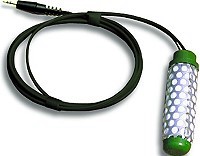Our Sensors
 As we previously mentioned, the motes contain light, humidity and temperature
sensors. It is also possible to attach additional
sensors, using a simple breadboard with 8 analog and 8 digital inputs, which
can be purchased separately. In order to study the gradients of the soil
moisture with depth, we will need to connect at least two, but ideally three
sensors, placed at different depths for each unit. We will be using the Watermark
sensors. These have a variable resistance affected by a changing Soil Water Potential.
There is anon-inear calibration that enables us to translate from resistance to SWP.
The resistance has a strong temperature dependence, thus we need to place an additional
soil thermometer next to each mote, the temparature into account when we
convert resistance to SWP.
As we previously mentioned, the motes contain light, humidity and temperature
sensors. It is also possible to attach additional
sensors, using a simple breadboard with 8 analog and 8 digital inputs, which
can be purchased separately. In order to study the gradients of the soil
moisture with depth, we will need to connect at least two, but ideally three
sensors, placed at different depths for each unit. We will be using the Watermark
sensors. These have a variable resistance affected by a changing Soil Water Potential.
There is anon-inear calibration that enables us to translate from resistance to SWP.
The resistance has a strong temperature dependence, thus we need to place an additional
soil thermometer next to each mote, the temparature into account when we
convert resistance to SWP.
 Local variations in the soil
respiration rate are reflected in the CO2concentration.
There is a small OEM CO2 sensor available from Telaire,
which has both a simple analog and a digital interface (UART). The soil
moisture sensors have a list price of about $29, while the CO2
sensor boards are listed at $250. We will interface both to the mote, and
deploy several hundreds of the moisture sensors, and several tens of the
CO2 sensors. We will also have multiple light sensors on a
few sensor boards, where filters will be placed before the light sensors, to be
able to determine the color composition of the light. During the first year, we
will test and deploy several different combinations of sensors and lock in a
small number of final configurations, which will then be widely deployed on all
the test sites.
Local variations in the soil
respiration rate are reflected in the CO2concentration.
There is a small OEM CO2 sensor available from Telaire,
which has both a simple analog and a digital interface (UART). The soil
moisture sensors have a list price of about $29, while the CO2
sensor boards are listed at $250. We will interface both to the mote, and
deploy several hundreds of the moisture sensors, and several tens of the
CO2 sensors. We will also have multiple light sensors on a
few sensor boards, where filters will be placed before the light sensors, to be
able to determine the color composition of the light. During the first year, we
will test and deploy several different combinations of sensors and lock in a
small number of final configurations, which will then be widely deployed on all
the test sites.
 We have just started to experiment with the ECH2O-5 sensor from
Decagon. These sensors are electronic,
based on measuring the soil dielectric constant via a high frequency oscillator,
and appear to have a much smaller temperature sensitivity.
We have just started to experiment with the ECH2O-5 sensor from
Decagon. These sensors are electronic,
based on measuring the soil dielectric constant via a high frequency oscillator,
and appear to have a much smaller temperature sensitivity.
We are building our own soil temperature sensors, using precision
thermistors from YSI Inc.
|

 As we previously mentioned, the motes contain light, humidity and temperature
sensors. It is also possible to attach additional
sensors, using a simple breadboard with 8 analog and 8 digital inputs, which
can be purchased separately. In order to study the gradients of the soil
moisture with depth, we will need to connect at least two, but ideally three
sensors, placed at different depths for each unit. We will be using the Watermark
sensors. These have a variable resistance affected by a changing Soil Water Potential.
There is anon-inear calibration that enables us to translate from resistance to SWP.
The resistance has a strong temperature dependence, thus we need to place an additional
soil thermometer next to each mote, the temparature into account when we
convert resistance to SWP.
As we previously mentioned, the motes contain light, humidity and temperature
sensors. It is also possible to attach additional
sensors, using a simple breadboard with 8 analog and 8 digital inputs, which
can be purchased separately. In order to study the gradients of the soil
moisture with depth, we will need to connect at least two, but ideally three
sensors, placed at different depths for each unit. We will be using the Watermark
sensors. These have a variable resistance affected by a changing Soil Water Potential.
There is anon-inear calibration that enables us to translate from resistance to SWP.
The resistance has a strong temperature dependence, thus we need to place an additional
soil thermometer next to each mote, the temparature into account when we
convert resistance to SWP.